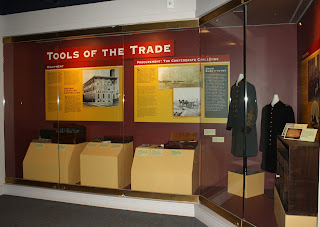Last Friday I was
out at the Pry House Field Hospital and Museum, the National Museum of Civil
War Medicine’s satellite location out on the Antietam Battlefield. In 1862, just prior to the Battle of
Antietam, the house was commandeered by General George McClellan for use as his
headquarters. Major General Joseph
Hooker and General Israel Richardson were treated there after the battle for
wounds they received. General Hooker
recovered, but General Richardson died in the house two months later. His death there resulted in some interesting
ghost stories about the house, but I’ll have to save those for a later post!
 |
| The Pry barn was used as a Field Hospital. If you were not a General, this was where you would be treated! Over 400 men were cared for here. |
The Pry House
closes over the winter, and so the reason for my being there last week was to
move the artifacts on display there back to the main museum. As you might imagine, moving artifacts
requires planning, some care, and lots of packing materials!
 |
| Very small items like this bullet are first put into a sealed, labeled bag. It will then be placed into a small box so that it doesn’t get lost in the packing materials! |
When a packing box is filed, all the empty spaces are then filled with more tissue and foam to prevent the items from shifting during transport. Lids are secured on the boxes to keep everything in place, to protect the packed items from the weather, and to buffer them from the change in environmental conditions as they are taken outside (remember last week’s post on the dangers of rapidly fluctuating temperatures and RH?).
 |
| Here’s the amputation kit with the instruments safely stored inside. |
 |
| Here’s the amputation kit under several layers of tissue and ethafoam! |
When the
artifacts arrive back at the museum, they are kept inside the closed containers
for at least 24 hours. This allows them
to acclimate to the new environmental conditions gradually. Then they are carefully unpacked, inspected
for any damage, and monitored for a month before being transferred back to
their storage places in the collection room.
If any conservation work is required on them, this is the time it is done! In the spring, they will be packed again and taken back out to their
display cases at the Pry House.
If you’re ever in
the area, please stop by and visit!
 |
| If you’re lucky, our unofficial mascot, Lacy, will be there to greet you! |
Photos courtesy of the
National Museum of Civil War Medicine
*Note: Due to the holidays, there will be no blog
post next week. Happy New Year everyone,
and thanks for reading my blog!





































